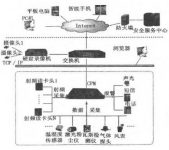
Application of Internet of Things Technology in Enterprise Safety Production
[ad_1]
The emergence of the Internet of Things has made up for the shortcomings of the above situation. Using the characteristics of the Internet of Things such as comprehensive perception, reliable transmission and intelligent processing, it can change production and lifestyle, actively promote the integration of the “three networks”, and make full use of the information technology of the Internet of Things. Improve the ability and level of enterprise safety production supervision and management, promote the improvement of enterprise economic efficiency, and reduce the occurrence of safety production accidents. Through sensors, radio frequency identification technology, global positioning system and other technologies, the Internet of Things collects any objects or processes that need to be monitored, connected, and interacted in real time, and collects various needs such as sound, light, heat, electricity, mechanics, chemistry, biology, location, etc. Through all kinds of possible network access, realize the ubiquitous link between things and things, things and people, and realize the intelligent perception, recognition and management of things and processes. The key issue of safe production lies in the early warning of safety accidents, which can be dealt with in a timely manner before the accident occurs. The Internet of Things technology can just solve this problem. Its application can make safe production have the ability to predict and predict, and can significantly improve the company’s all-round security defense capabilities.
According to the actual production safety problems existing in the current production process of enterprises, this paper proposes a comprehensive solution based on Internet of Things technology-enterprise Internet of Things security integrated monitoring system, the following will be from the overall design of the system, functional realization and application examples, etc. Comprehensive introduction to the system.
1 Enterprise Internet of Things Security Comprehensive Monitoring System Design
The enterprise security monitoring emergency management information system is a multi-level, multi-angle, multi-business comprehensive information system. It is a complex combination of multiple systems. It is a unified and complete complex system. Divided from different angles or different levels, the system can be divided into different architectures. The system connects various security monitoring equipment with the network around people, as shown in Figure 1.
The system is mainly composed of sensor network-based IoT relays, gateway devices, base stations, ordinary mobile phones, notebooks, desktop PCs, and IPAD handheld terminals.These integratedwirelessThe IoT patch panel of the sensor network can independently form a multi-hop network. Various safety monitoring sensors connected to it send data to the relay through the sensor network and the wired network, and then are processed by the CPM server in a more intuitive way. Users, while saving records in the system database. At the same time, the status information of the device itself can also be transmitted to the server for easy management. Users can remotely log in to the management system through various terminal devices. Real-time monitoring of various security conditions. And can view and promptly warn safety issues at any time, avoid the occurrence of safety accidents, and realize intelligent automatic control.
1.1 Topology
The topological structure is mainly composed of four parts (see Figure 1):

Figure 1 Topological structure diagram
Collection part: mainly through some wired andwirelessEnvironmental monitoring sensor equipment, through the sensor network or the Internet for transmission of collected data. Data processing part: The core of data processing is the CPM server, which receives, stores, analyzes and processes the collected data through different processing modules.
Control terminal: Including commonly used personal terminals such as PCs, smart phones, and IPAD tablets.
Transmission equipment: including fiber optic cables, twisted pair cables, switches, routers, firewalls, etc.
1.2 System function composition
The system structure diagram is shown in Figure 2.

Figure 2 System structure diagram
[ad_2]




